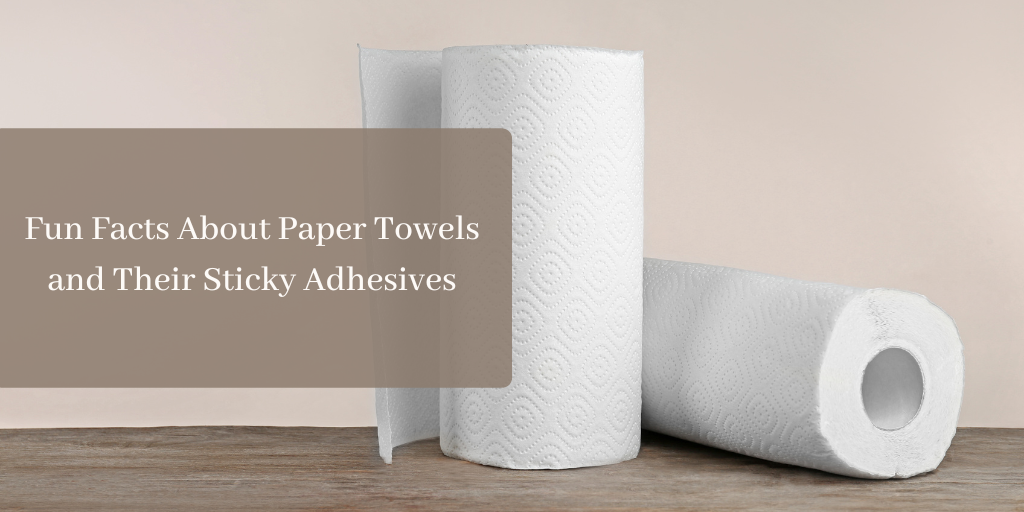Paper towels are a product that nearly everyone is familiar with. They’re convenient: all you do is reach for a roll, give it a tug, and rip off a sheet to handle a spill, wipe a counter, or grab a quick snack. They are simple, everyday products that many of us do not think twice about. But what if we told you there was a fascinating story of engineering and sticky science behind the manufacturing of paper towels? From those perfectly perforated lines to the adhesives that keep it all together, the paper towel is a lot more complex than it seems.
At LD Davis, we’ve been in the adhesive industry for a considerable time and are approaching our 100-year anniversary in 2026. So, as a celebration, we’re exploring the various products and industries that our glue influences. In this blog, we’ll take a look at how the paper towel came to be and discover the secrets behind one of the world’s most useful inventions.
The History of Paper Towels
The paper towel we know today was invented from a simple need for better hygiene. In the early 20th century, Scott Paper Company learned that its large paper rolls, originally manufactured for use in toilet stalls, could also be sold as a disposable hand-drying solution. These paper towels helped prevent the spread of germs better, compared to the average consumer’s reusable cloth handkerchiefs.
Today, paper towels are more than a way to quickly recover from a spill. Their versatility allows them to be used for everything from straining food and protecting produce in the fridge to serving as a quick-and-easy craft supply. The secret to their utility lies in how absorbent they are. Made most commonly from cellulose fibers, paper towels are designed to absorb liquids through a process called capillary action, where liquid is pulled into small spaces between the fibers, allowing them to soak up moisture.
The Secret to Perforations
Have you ever reached for a paper towel, pulled, and gotten that perfect, clean tear? That is not by chance; it’s the result of engineering. The lines you see on a paper towel roll are called perforations and they’re specifically designed to create a clean break point.
When a paper towel roll is running through the manufacturing line, a sharp blade or wheel with tiny teeth runs along the paper to create these perforations, leaving behind microscopic “bridges” of uncut paper in between each tear. These bridges are strong enough to keep the roll together as it spins on its holder, but weak enough to break with a simple tug. This is an example of something called stress concentration in engineering – the perforations create a series of weak points, ensuring the paper tears right where you want it to, every time. Without this design, the entire roll would simply unravel.
Adhesives in Paper Towel Manufacturing
While it may seem like the perforations get all of the attention, the real hero of the paper towel roll is the adhesive. This is where LD Davis comes in. We manufacture eco-friendly glues that are formulated with natural ingredients, including gelatin, glycerin, water, Epsom salt, and corn sugar. These raw materials are naturally recyclable and biodegradable. Since paper towels are so commonplace, it is important that our adhesive is safe for handling. Aside from the glue used in the creping process, there are two other places where glue plays a crucial role.
First, there’s the glue that secures the beginning of the paper towel roll to the cardboard tube at its core. This glue is often a water-based adhesive, like a starch or dextrin-based mixture. It must be strong enough to hold the roll together without it slipping or spinning. Applied quickly and fast-drying, this adhesive allows for high-speed manufacturing. Providing an anchor point for the entire roll, this glue ensures that the paper towels can be used conveniently and without mess.
Second, there is a small, removable adhesive dot or strip that holds the last sheet of paper on the roll in place. A pressure-sensitive adhesive, this glue sticks when pressure is applied and can be easily peeled off without damaging the paper. Its purpose is to prevent the roll from unraveling during shipping.
Surprising Paper Towel Facts
- A single paper towel roll can absorb more than 20 times its weight in liquid.
- The bumpy, textured surface of some paper towels isn’t just for looks. It is a design choice to create a larger surface area, making the towel more absorbent and more effective at scrubbing.
- The average American household uses more than 50 paper towel rolls in a year.
Your Partner in Adhesive Solutions
At LD Davis, we know that every adhesive has a specific purpose. We do not just make glue; we create custom solutions tailored to the needs of each product. The glues in paper towels must be non-toxic, have the right tack and drying time, and bond perfectly. The same principles that create a perfect paper towel roll are applied to all our adhesive solutions, from packaging to industrial manufacturing.
The next time you reach for a paper towel, take a moment to appreciate the engineering and sticky science that made it possible. From the perfect perforations to the essential adhesives, this everyday product is an example of clever design.
We’re proud to be a part of the science of everyday life at LD Davis and look forward to the opportunity to create more adhesive solutions that make a difference. Whether you’re looking for adhesives for your next paper towel project or want to learn more about our custom adhesive solutions, do not hesitate to contact us today.






